Constitutional Law: Separation of Powers and Article 9 in Singapore
VerifiedAdded on 2022/11/24
|11
|3322
|481
Homework Assignment
AI Summary
This assignment provides an in-depth analysis of the separation of powers within the Singaporean Constitution, focusing on the roles of the legislature, executive, and judiciary. It examines how these branches of government are designed to operate independently and the checks and balances in place to prevent abuse of power. The assignment specifically addresses Article 9 of the Constitution, which protects the right to life and personal liberty, and explores its interpretation through key case law, including Yong Vui Kong v Public Prosecutor, and others like Lo Pui Sang and others v Mamata Kapildev Dave and others. The discussion covers how the courts have defined 'personal liberty' and the scope of the state's obligations in relation to these rights. The assignment also highlights the concept of constitutional supremacy and the judiciary's role as a guardian of the Constitution, ensuring that all government actions comply with the established legal framework.
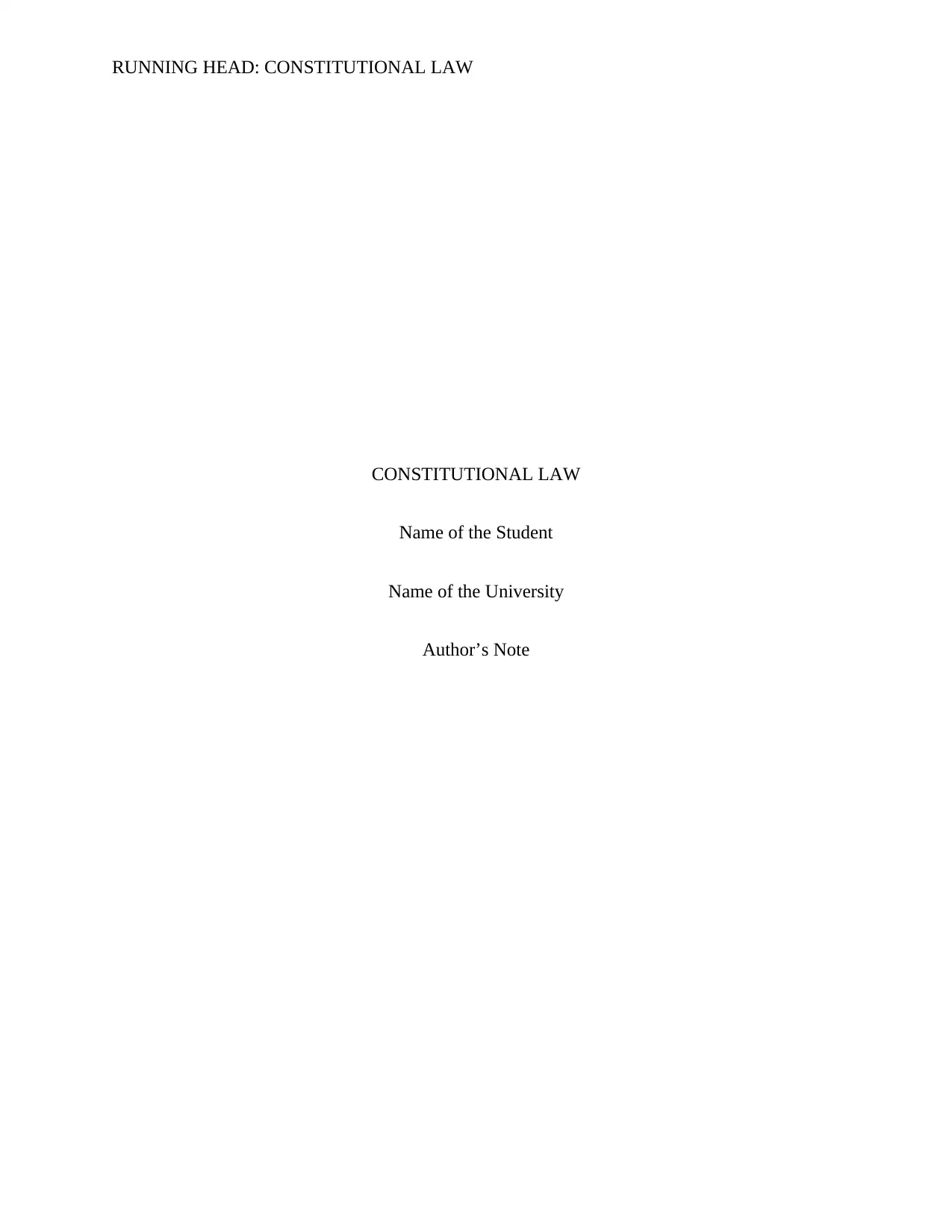
RUNNING HEAD: CONSTITUTIONAL LAW
CONSTITUTIONAL LAW
Name of the Student
Name of the University
Author’s Note
CONSTITUTIONAL LAW
Name of the Student
Name of the University
Author’s Note
Paraphrase This Document
Need a fresh take? Get an instant paraphrase of this document with our AI Paraphraser
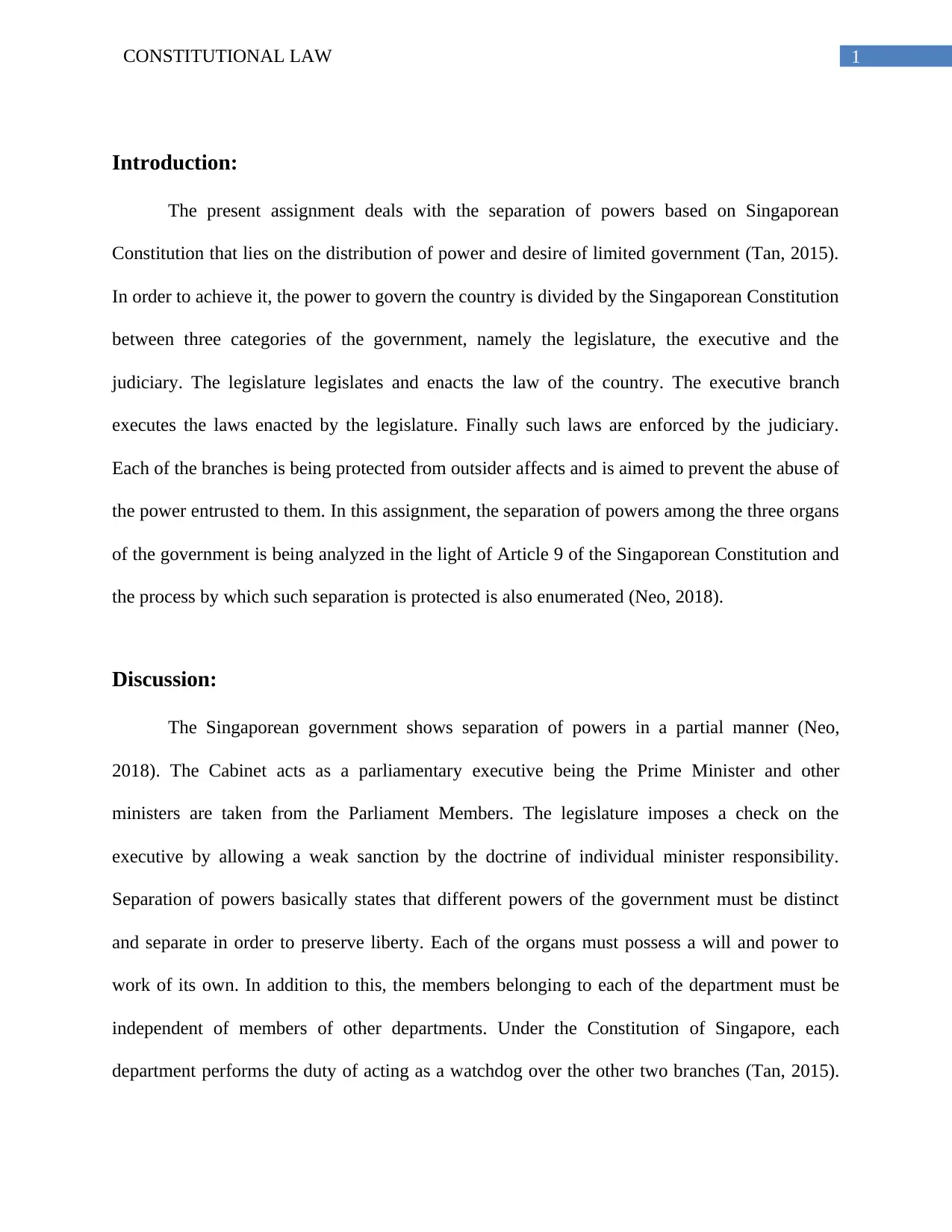
1CONSTITUTIONAL LAW
Introduction:
The present assignment deals with the separation of powers based on Singaporean
Constitution that lies on the distribution of power and desire of limited government (Tan, 2015).
In order to achieve it, the power to govern the country is divided by the Singaporean Constitution
between three categories of the government, namely the legislature, the executive and the
judiciary. The legislature legislates and enacts the law of the country. The executive branch
executes the laws enacted by the legislature. Finally such laws are enforced by the judiciary.
Each of the branches is being protected from outsider affects and is aimed to prevent the abuse of
the power entrusted to them. In this assignment, the separation of powers among the three organs
of the government is being analyzed in the light of Article 9 of the Singaporean Constitution and
the process by which such separation is protected is also enumerated (Neo, 2018).
Discussion:
The Singaporean government shows separation of powers in a partial manner (Neo,
2018). The Cabinet acts as a parliamentary executive being the Prime Minister and other
ministers are taken from the Parliament Members. The legislature imposes a check on the
executive by allowing a weak sanction by the doctrine of individual minister responsibility.
Separation of powers basically states that different powers of the government must be distinct
and separate in order to preserve liberty. Each of the organs must possess a will and power to
work of its own. In addition to this, the members belonging to each of the department must be
independent of members of other departments. Under the Constitution of Singapore, each
department performs the duty of acting as a watchdog over the other two branches (Tan, 2015).
Introduction:
The present assignment deals with the separation of powers based on Singaporean
Constitution that lies on the distribution of power and desire of limited government (Tan, 2015).
In order to achieve it, the power to govern the country is divided by the Singaporean Constitution
between three categories of the government, namely the legislature, the executive and the
judiciary. The legislature legislates and enacts the law of the country. The executive branch
executes the laws enacted by the legislature. Finally such laws are enforced by the judiciary.
Each of the branches is being protected from outsider affects and is aimed to prevent the abuse of
the power entrusted to them. In this assignment, the separation of powers among the three organs
of the government is being analyzed in the light of Article 9 of the Singaporean Constitution and
the process by which such separation is protected is also enumerated (Neo, 2018).
Discussion:
The Singaporean government shows separation of powers in a partial manner (Neo,
2018). The Cabinet acts as a parliamentary executive being the Prime Minister and other
ministers are taken from the Parliament Members. The legislature imposes a check on the
executive by allowing a weak sanction by the doctrine of individual minister responsibility.
Separation of powers basically states that different powers of the government must be distinct
and separate in order to preserve liberty. Each of the organs must possess a will and power to
work of its own. In addition to this, the members belonging to each of the department must be
independent of members of other departments. Under the Constitution of Singapore, each
department performs the duty of acting as a watchdog over the other two branches (Tan, 2015).
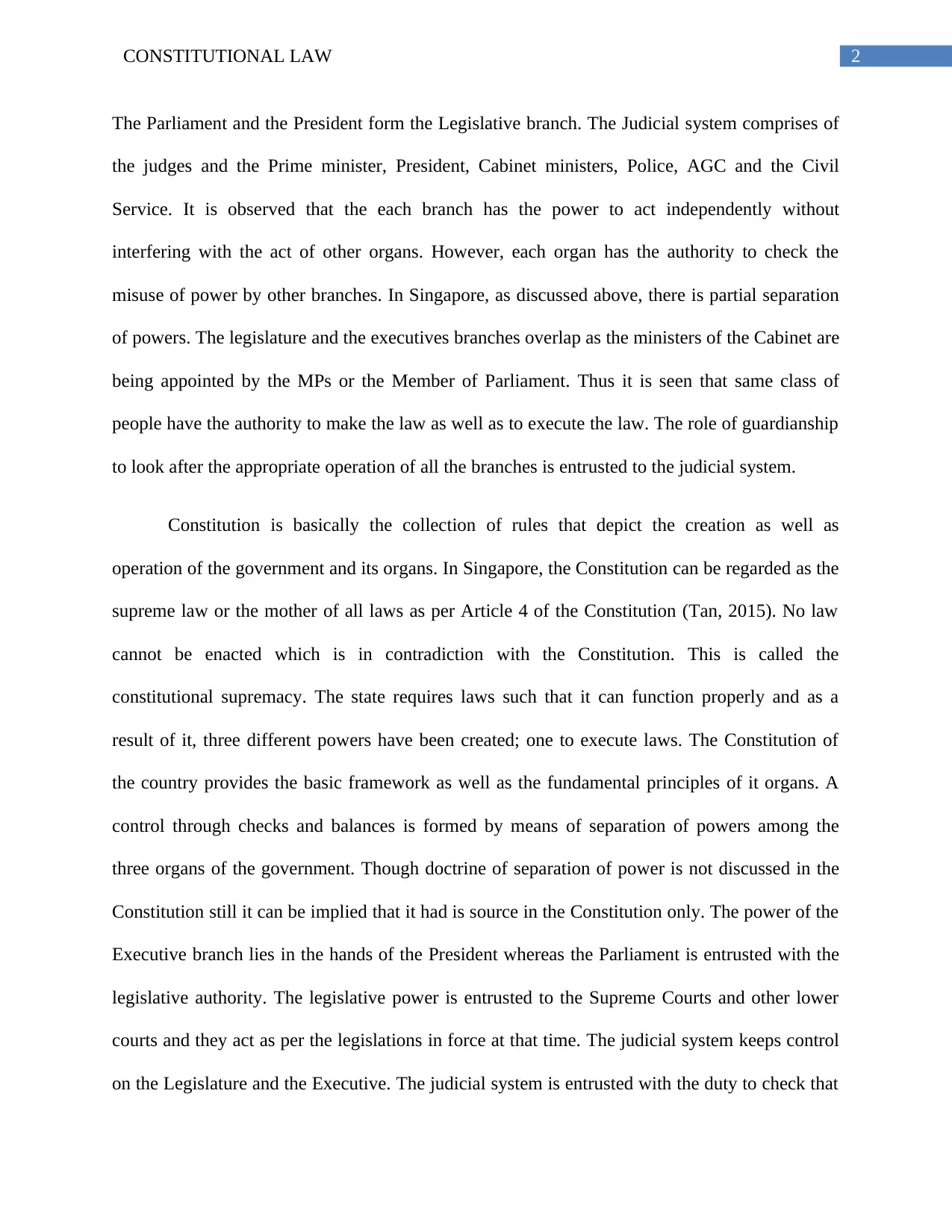
2CONSTITUTIONAL LAW
The Parliament and the President form the Legislative branch. The Judicial system comprises of
the judges and the Prime minister, President, Cabinet ministers, Police, AGC and the Civil
Service. It is observed that the each branch has the power to act independently without
interfering with the act of other organs. However, each organ has the authority to check the
misuse of power by other branches. In Singapore, as discussed above, there is partial separation
of powers. The legislature and the executives branches overlap as the ministers of the Cabinet are
being appointed by the MPs or the Member of Parliament. Thus it is seen that same class of
people have the authority to make the law as well as to execute the law. The role of guardianship
to look after the appropriate operation of all the branches is entrusted to the judicial system.
Constitution is basically the collection of rules that depict the creation as well as
operation of the government and its organs. In Singapore, the Constitution can be regarded as the
supreme law or the mother of all laws as per Article 4 of the Constitution (Tan, 2015). No law
cannot be enacted which is in contradiction with the Constitution. This is called the
constitutional supremacy. The state requires laws such that it can function properly and as a
result of it, three different powers have been created; one to execute laws. The Constitution of
the country provides the basic framework as well as the fundamental principles of it organs. A
control through checks and balances is formed by means of separation of powers among the
three organs of the government. Though doctrine of separation of power is not discussed in the
Constitution still it can be implied that it had is source in the Constitution only. The power of the
Executive branch lies in the hands of the President whereas the Parliament is entrusted with the
legislative authority. The legislative power is entrusted to the Supreme Courts and other lower
courts and they act as per the legislations in force at that time. The judicial system keeps control
on the Legislature and the Executive. The judicial system is entrusted with the duty to check that
The Parliament and the President form the Legislative branch. The Judicial system comprises of
the judges and the Prime minister, President, Cabinet ministers, Police, AGC and the Civil
Service. It is observed that the each branch has the power to act independently without
interfering with the act of other organs. However, each organ has the authority to check the
misuse of power by other branches. In Singapore, as discussed above, there is partial separation
of powers. The legislature and the executives branches overlap as the ministers of the Cabinet are
being appointed by the MPs or the Member of Parliament. Thus it is seen that same class of
people have the authority to make the law as well as to execute the law. The role of guardianship
to look after the appropriate operation of all the branches is entrusted to the judicial system.
Constitution is basically the collection of rules that depict the creation as well as
operation of the government and its organs. In Singapore, the Constitution can be regarded as the
supreme law or the mother of all laws as per Article 4 of the Constitution (Tan, 2015). No law
cannot be enacted which is in contradiction with the Constitution. This is called the
constitutional supremacy. The state requires laws such that it can function properly and as a
result of it, three different powers have been created; one to execute laws. The Constitution of
the country provides the basic framework as well as the fundamental principles of it organs. A
control through checks and balances is formed by means of separation of powers among the
three organs of the government. Though doctrine of separation of power is not discussed in the
Constitution still it can be implied that it had is source in the Constitution only. The power of the
Executive branch lies in the hands of the President whereas the Parliament is entrusted with the
legislative authority. The legislative power is entrusted to the Supreme Courts and other lower
courts and they act as per the legislations in force at that time. The judicial system keeps control
on the Legislature and the Executive. The judicial system is entrusted with the duty to check that
⊘ This is a preview!⊘
Do you want full access?
Subscribe today to unlock all pages.

Trusted by 1+ million students worldwide
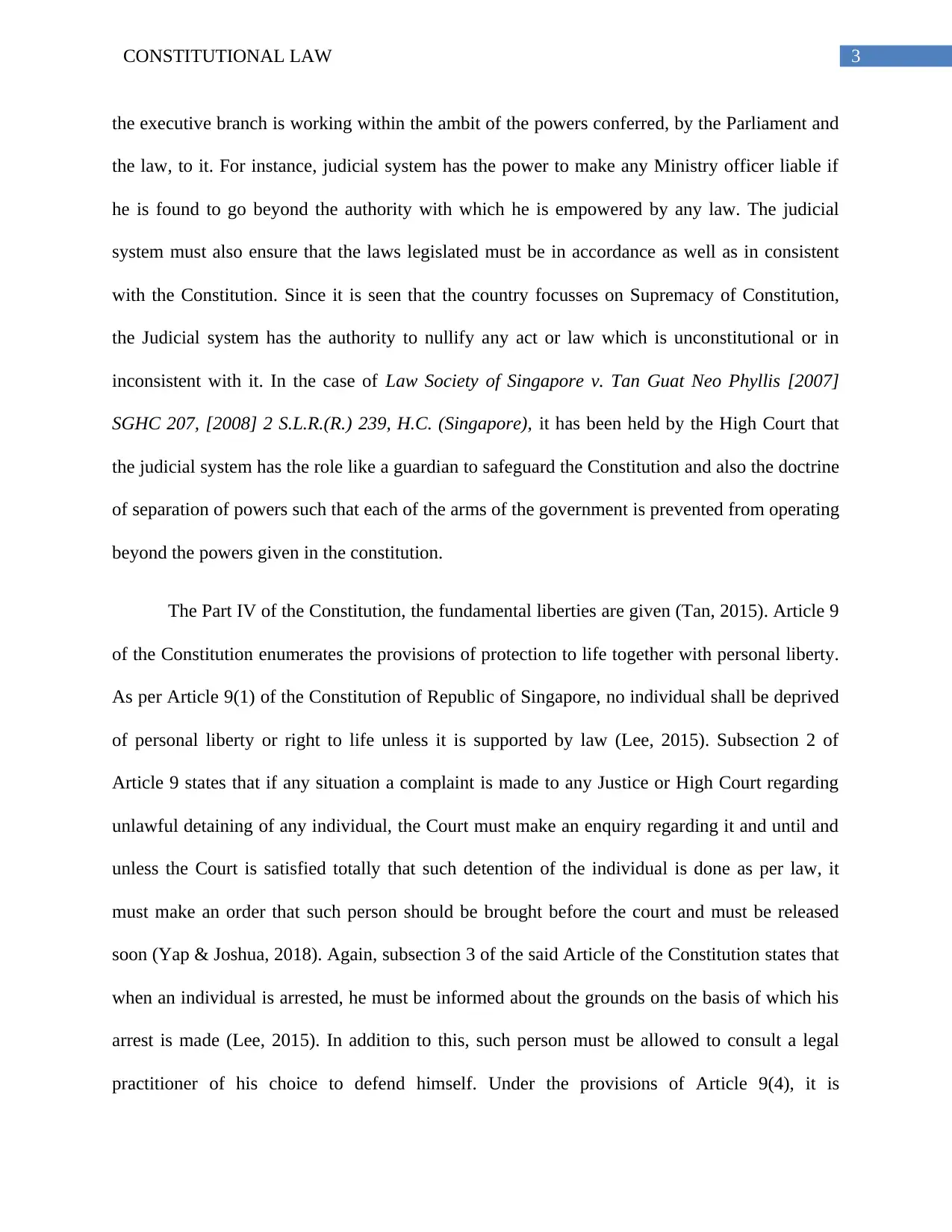
3CONSTITUTIONAL LAW
the executive branch is working within the ambit of the powers conferred, by the Parliament and
the law, to it. For instance, judicial system has the power to make any Ministry officer liable if
he is found to go beyond the authority with which he is empowered by any law. The judicial
system must also ensure that the laws legislated must be in accordance as well as in consistent
with the Constitution. Since it is seen that the country focusses on Supremacy of Constitution,
the Judicial system has the authority to nullify any act or law which is unconstitutional or in
inconsistent with it. In the case of Law Society of Singapore v. Tan Guat Neo Phyllis [2007]
SGHC 207, [2008] 2 S.L.R.(R.) 239, H.C. (Singapore), it has been held by the High Court that
the judicial system has the role like a guardian to safeguard the Constitution and also the doctrine
of separation of powers such that each of the arms of the government is prevented from operating
beyond the powers given in the constitution.
The Part IV of the Constitution, the fundamental liberties are given (Tan, 2015). Article 9
of the Constitution enumerates the provisions of protection to life together with personal liberty.
As per Article 9(1) of the Constitution of Republic of Singapore, no individual shall be deprived
of personal liberty or right to life unless it is supported by law (Lee, 2015). Subsection 2 of
Article 9 states that if any situation a complaint is made to any Justice or High Court regarding
unlawful detaining of any individual, the Court must make an enquiry regarding it and until and
unless the Court is satisfied totally that such detention of the individual is done as per law, it
must make an order that such person should be brought before the court and must be released
soon (Yap & Joshua, 2018). Again, subsection 3 of the said Article of the Constitution states that
when an individual is arrested, he must be informed about the grounds on the basis of which his
arrest is made (Lee, 2015). In addition to this, such person must be allowed to consult a legal
practitioner of his choice to defend himself. Under the provisions of Article 9(4), it is
the executive branch is working within the ambit of the powers conferred, by the Parliament and
the law, to it. For instance, judicial system has the power to make any Ministry officer liable if
he is found to go beyond the authority with which he is empowered by any law. The judicial
system must also ensure that the laws legislated must be in accordance as well as in consistent
with the Constitution. Since it is seen that the country focusses on Supremacy of Constitution,
the Judicial system has the authority to nullify any act or law which is unconstitutional or in
inconsistent with it. In the case of Law Society of Singapore v. Tan Guat Neo Phyllis [2007]
SGHC 207, [2008] 2 S.L.R.(R.) 239, H.C. (Singapore), it has been held by the High Court that
the judicial system has the role like a guardian to safeguard the Constitution and also the doctrine
of separation of powers such that each of the arms of the government is prevented from operating
beyond the powers given in the constitution.
The Part IV of the Constitution, the fundamental liberties are given (Tan, 2015). Article 9
of the Constitution enumerates the provisions of protection to life together with personal liberty.
As per Article 9(1) of the Constitution of Republic of Singapore, no individual shall be deprived
of personal liberty or right to life unless it is supported by law (Lee, 2015). Subsection 2 of
Article 9 states that if any situation a complaint is made to any Justice or High Court regarding
unlawful detaining of any individual, the Court must make an enquiry regarding it and until and
unless the Court is satisfied totally that such detention of the individual is done as per law, it
must make an order that such person should be brought before the court and must be released
soon (Yap & Joshua, 2018). Again, subsection 3 of the said Article of the Constitution states that
when an individual is arrested, he must be informed about the grounds on the basis of which his
arrest is made (Lee, 2015). In addition to this, such person must be allowed to consult a legal
practitioner of his choice to defend himself. Under the provisions of Article 9(4), it is
Paraphrase This Document
Need a fresh take? Get an instant paraphrase of this document with our AI Paraphraser
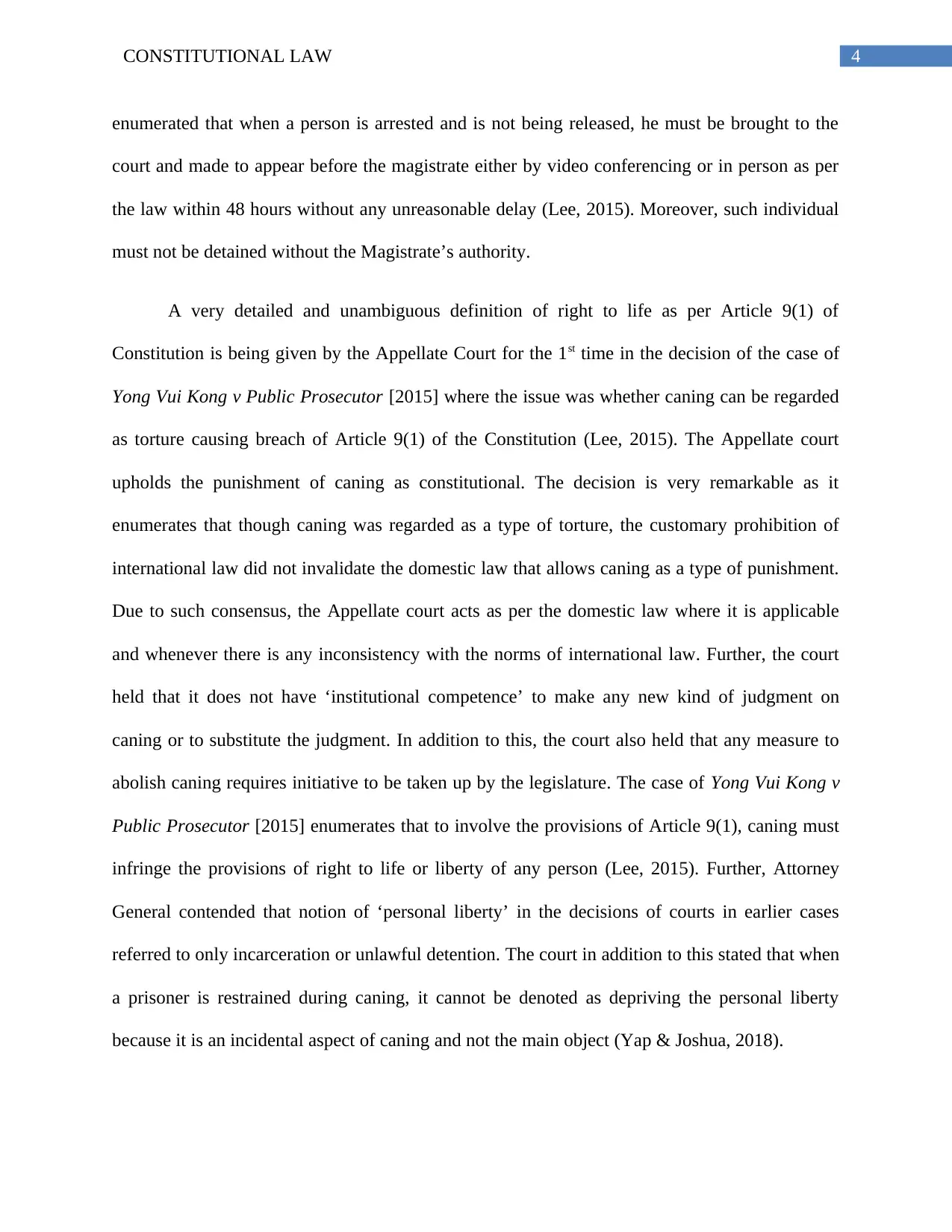
4CONSTITUTIONAL LAW
enumerated that when a person is arrested and is not being released, he must be brought to the
court and made to appear before the magistrate either by video conferencing or in person as per
the law within 48 hours without any unreasonable delay (Lee, 2015). Moreover, such individual
must not be detained without the Magistrate’s authority.
A very detailed and unambiguous definition of right to life as per Article 9(1) of
Constitution is being given by the Appellate Court for the 1st time in the decision of the case of
Yong Vui Kong v Public Prosecutor [2015] where the issue was whether caning can be regarded
as torture causing breach of Article 9(1) of the Constitution (Lee, 2015). The Appellate court
upholds the punishment of caning as constitutional. The decision is very remarkable as it
enumerates that though caning was regarded as a type of torture, the customary prohibition of
international law did not invalidate the domestic law that allows caning as a type of punishment.
Due to such consensus, the Appellate court acts as per the domestic law where it is applicable
and whenever there is any inconsistency with the norms of international law. Further, the court
held that it does not have ‘institutional competence’ to make any new kind of judgment on
caning or to substitute the judgment. In addition to this, the court also held that any measure to
abolish caning requires initiative to be taken up by the legislature. The case of Yong Vui Kong v
Public Prosecutor [2015] enumerates that to involve the provisions of Article 9(1), caning must
infringe the provisions of right to life or liberty of any person (Lee, 2015). Further, Attorney
General contended that notion of ‘personal liberty’ in the decisions of courts in earlier cases
referred to only incarceration or unlawful detention. The court in addition to this stated that when
a prisoner is restrained during caning, it cannot be denoted as depriving the personal liberty
because it is an incidental aspect of caning and not the main object (Yap & Joshua, 2018).
enumerated that when a person is arrested and is not being released, he must be brought to the
court and made to appear before the magistrate either by video conferencing or in person as per
the law within 48 hours without any unreasonable delay (Lee, 2015). Moreover, such individual
must not be detained without the Magistrate’s authority.
A very detailed and unambiguous definition of right to life as per Article 9(1) of
Constitution is being given by the Appellate Court for the 1st time in the decision of the case of
Yong Vui Kong v Public Prosecutor [2015] where the issue was whether caning can be regarded
as torture causing breach of Article 9(1) of the Constitution (Lee, 2015). The Appellate court
upholds the punishment of caning as constitutional. The decision is very remarkable as it
enumerates that though caning was regarded as a type of torture, the customary prohibition of
international law did not invalidate the domestic law that allows caning as a type of punishment.
Due to such consensus, the Appellate court acts as per the domestic law where it is applicable
and whenever there is any inconsistency with the norms of international law. Further, the court
held that it does not have ‘institutional competence’ to make any new kind of judgment on
caning or to substitute the judgment. In addition to this, the court also held that any measure to
abolish caning requires initiative to be taken up by the legislature. The case of Yong Vui Kong v
Public Prosecutor [2015] enumerates that to involve the provisions of Article 9(1), caning must
infringe the provisions of right to life or liberty of any person (Lee, 2015). Further, Attorney
General contended that notion of ‘personal liberty’ in the decisions of courts in earlier cases
referred to only incarceration or unlawful detention. The court in addition to this stated that when
a prisoner is restrained during caning, it cannot be denoted as depriving the personal liberty
because it is an incidental aspect of caning and not the main object (Yap & Joshua, 2018).
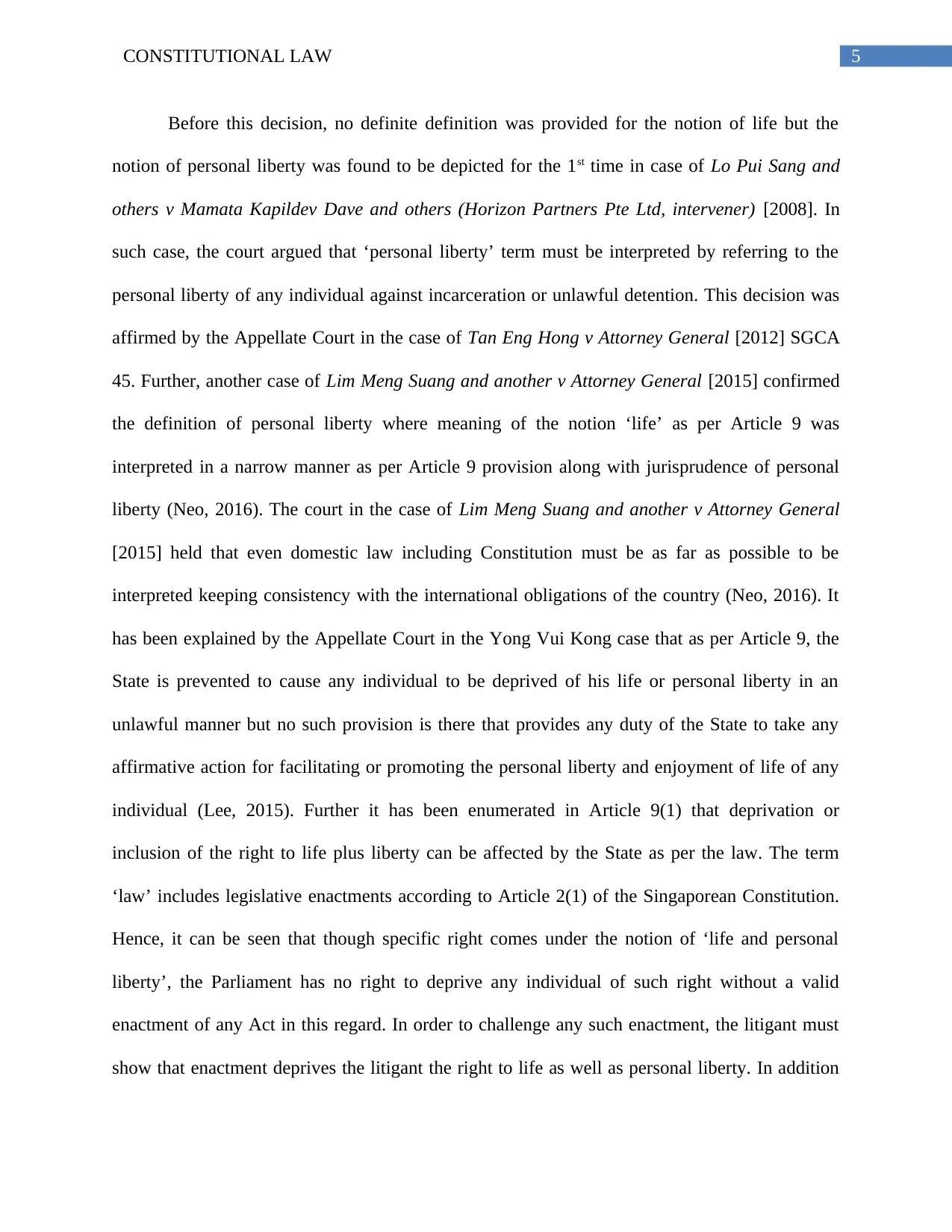
5CONSTITUTIONAL LAW
Before this decision, no definite definition was provided for the notion of life but the
notion of personal liberty was found to be depicted for the 1st time in case of Lo Pui Sang and
others v Mamata Kapildev Dave and others (Horizon Partners Pte Ltd, intervener) [2008]. In
such case, the court argued that ‘personal liberty’ term must be interpreted by referring to the
personal liberty of any individual against incarceration or unlawful detention. This decision was
affirmed by the Appellate Court in the case of Tan Eng Hong v Attorney General [2012] SGCA
45. Further, another case of Lim Meng Suang and another v Attorney General [2015] confirmed
the definition of personal liberty where meaning of the notion ‘life’ as per Article 9 was
interpreted in a narrow manner as per Article 9 provision along with jurisprudence of personal
liberty (Neo, 2016). The court in the case of Lim Meng Suang and another v Attorney General
[2015] held that even domestic law including Constitution must be as far as possible to be
interpreted keeping consistency with the international obligations of the country (Neo, 2016). It
has been explained by the Appellate Court in the Yong Vui Kong case that as per Article 9, the
State is prevented to cause any individual to be deprived of his life or personal liberty in an
unlawful manner but no such provision is there that provides any duty of the State to take any
affirmative action for facilitating or promoting the personal liberty and enjoyment of life of any
individual (Lee, 2015). Further it has been enumerated in Article 9(1) that deprivation or
inclusion of the right to life plus liberty can be affected by the State as per the law. The term
‘law’ includes legislative enactments according to Article 2(1) of the Singaporean Constitution.
Hence, it can be seen that though specific right comes under the notion of ‘life and personal
liberty’, the Parliament has no right to deprive any individual of such right without a valid
enactment of any Act in this regard. In order to challenge any such enactment, the litigant must
show that enactment deprives the litigant the right to life as well as personal liberty. In addition
Before this decision, no definite definition was provided for the notion of life but the
notion of personal liberty was found to be depicted for the 1st time in case of Lo Pui Sang and
others v Mamata Kapildev Dave and others (Horizon Partners Pte Ltd, intervener) [2008]. In
such case, the court argued that ‘personal liberty’ term must be interpreted by referring to the
personal liberty of any individual against incarceration or unlawful detention. This decision was
affirmed by the Appellate Court in the case of Tan Eng Hong v Attorney General [2012] SGCA
45. Further, another case of Lim Meng Suang and another v Attorney General [2015] confirmed
the definition of personal liberty where meaning of the notion ‘life’ as per Article 9 was
interpreted in a narrow manner as per Article 9 provision along with jurisprudence of personal
liberty (Neo, 2016). The court in the case of Lim Meng Suang and another v Attorney General
[2015] held that even domestic law including Constitution must be as far as possible to be
interpreted keeping consistency with the international obligations of the country (Neo, 2016). It
has been explained by the Appellate Court in the Yong Vui Kong case that as per Article 9, the
State is prevented to cause any individual to be deprived of his life or personal liberty in an
unlawful manner but no such provision is there that provides any duty of the State to take any
affirmative action for facilitating or promoting the personal liberty and enjoyment of life of any
individual (Lee, 2015). Further it has been enumerated in Article 9(1) that deprivation or
inclusion of the right to life plus liberty can be affected by the State as per the law. The term
‘law’ includes legislative enactments according to Article 2(1) of the Singaporean Constitution.
Hence, it can be seen that though specific right comes under the notion of ‘life and personal
liberty’, the Parliament has no right to deprive any individual of such right without a valid
enactment of any Act in this regard. In order to challenge any such enactment, the litigant must
show that enactment deprives the litigant the right to life as well as personal liberty. In addition
⊘ This is a preview!⊘
Do you want full access?
Subscribe today to unlock all pages.

Trusted by 1+ million students worldwide
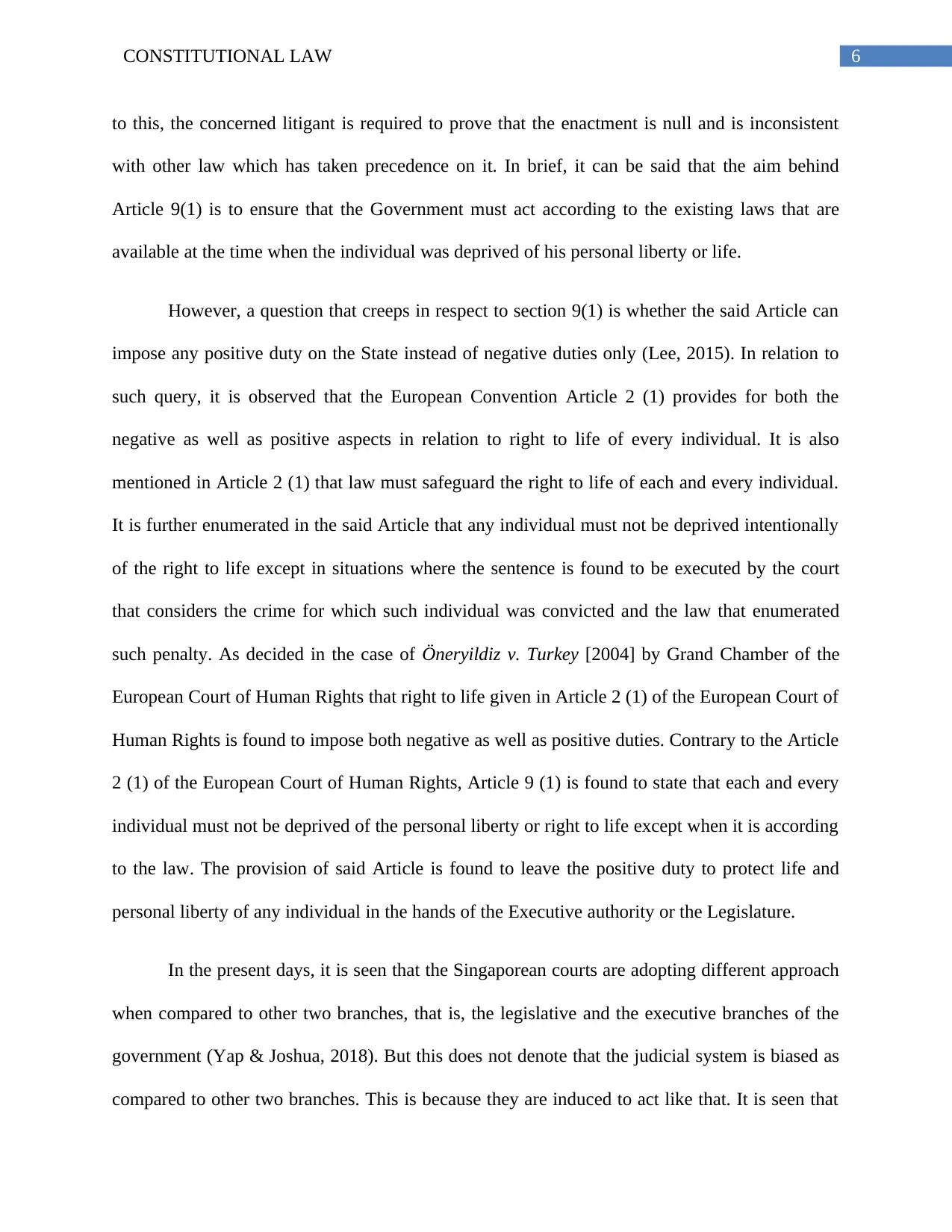
6CONSTITUTIONAL LAW
to this, the concerned litigant is required to prove that the enactment is null and is inconsistent
with other law which has taken precedence on it. In brief, it can be said that the aim behind
Article 9(1) is to ensure that the Government must act according to the existing laws that are
available at the time when the individual was deprived of his personal liberty or life.
However, a question that creeps in respect to section 9(1) is whether the said Article can
impose any positive duty on the State instead of negative duties only (Lee, 2015). In relation to
such query, it is observed that the European Convention Article 2 (1) provides for both the
negative as well as positive aspects in relation to right to life of every individual. It is also
mentioned in Article 2 (1) that law must safeguard the right to life of each and every individual.
It is further enumerated in the said Article that any individual must not be deprived intentionally
of the right to life except in situations where the sentence is found to be executed by the court
that considers the crime for which such individual was convicted and the law that enumerated
such penalty. As decided in the case of Öneryildiz v. Turkey [2004] by Grand Chamber of the
European Court of Human Rights that right to life given in Article 2 (1) of the European Court of
Human Rights is found to impose both negative as well as positive duties. Contrary to the Article
2 (1) of the European Court of Human Rights, Article 9 (1) is found to state that each and every
individual must not be deprived of the personal liberty or right to life except when it is according
to the law. The provision of said Article is found to leave the positive duty to protect life and
personal liberty of any individual in the hands of the Executive authority or the Legislature.
In the present days, it is seen that the Singaporean courts are adopting different approach
when compared to other two branches, that is, the legislative and the executive branches of the
government (Yap & Joshua, 2018). But this does not denote that the judicial system is biased as
compared to other two branches. This is because they are induced to act like that. It is seen that
to this, the concerned litigant is required to prove that the enactment is null and is inconsistent
with other law which has taken precedence on it. In brief, it can be said that the aim behind
Article 9(1) is to ensure that the Government must act according to the existing laws that are
available at the time when the individual was deprived of his personal liberty or life.
However, a question that creeps in respect to section 9(1) is whether the said Article can
impose any positive duty on the State instead of negative duties only (Lee, 2015). In relation to
such query, it is observed that the European Convention Article 2 (1) provides for both the
negative as well as positive aspects in relation to right to life of every individual. It is also
mentioned in Article 2 (1) that law must safeguard the right to life of each and every individual.
It is further enumerated in the said Article that any individual must not be deprived intentionally
of the right to life except in situations where the sentence is found to be executed by the court
that considers the crime for which such individual was convicted and the law that enumerated
such penalty. As decided in the case of Öneryildiz v. Turkey [2004] by Grand Chamber of the
European Court of Human Rights that right to life given in Article 2 (1) of the European Court of
Human Rights is found to impose both negative as well as positive duties. Contrary to the Article
2 (1) of the European Court of Human Rights, Article 9 (1) is found to state that each and every
individual must not be deprived of the personal liberty or right to life except when it is according
to the law. The provision of said Article is found to leave the positive duty to protect life and
personal liberty of any individual in the hands of the Executive authority or the Legislature.
In the present days, it is seen that the Singaporean courts are adopting different approach
when compared to other two branches, that is, the legislative and the executive branches of the
government (Yap & Joshua, 2018). But this does not denote that the judicial system is biased as
compared to other two branches. This is because they are induced to act like that. It is seen that
Paraphrase This Document
Need a fresh take? Get an instant paraphrase of this document with our AI Paraphraser
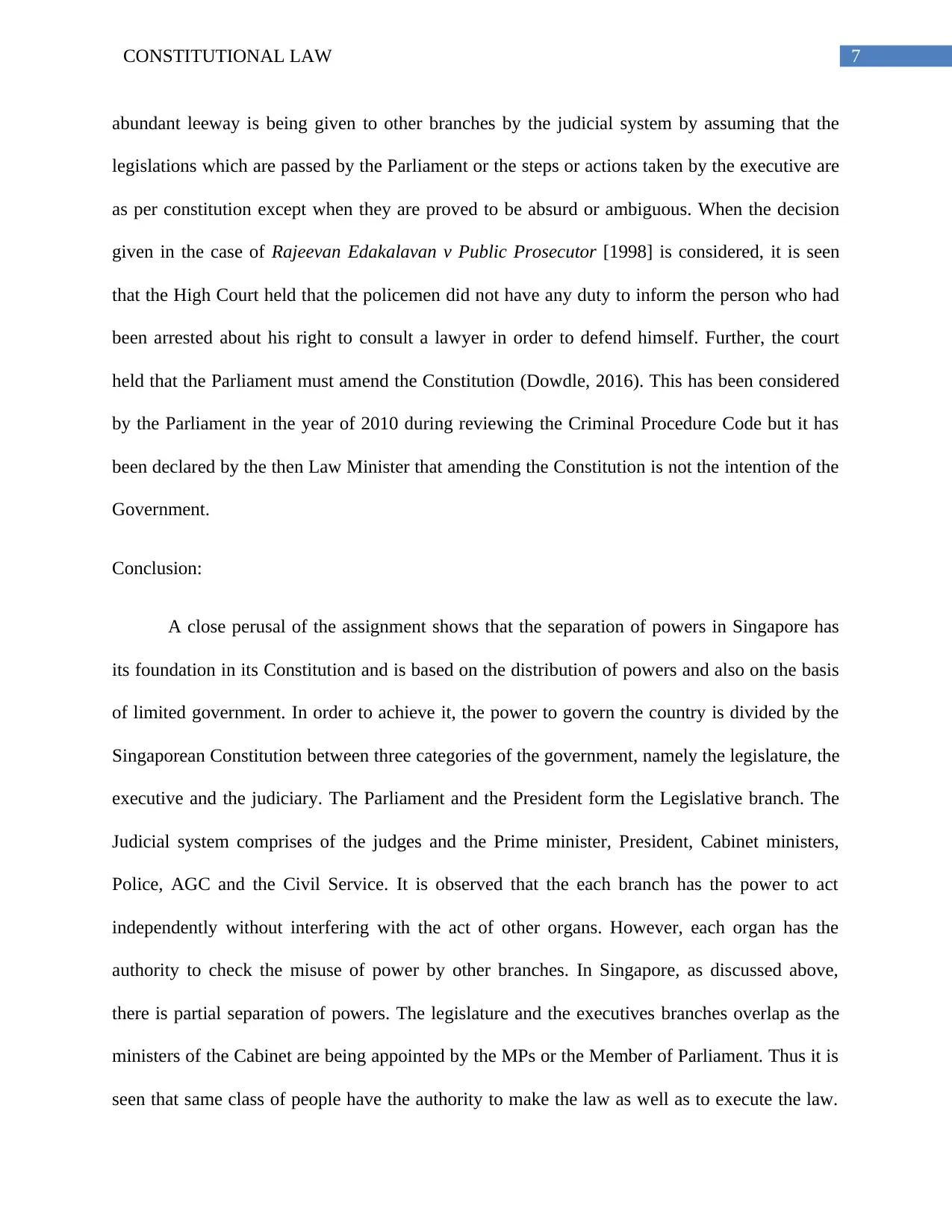
7CONSTITUTIONAL LAW
abundant leeway is being given to other branches by the judicial system by assuming that the
legislations which are passed by the Parliament or the steps or actions taken by the executive are
as per constitution except when they are proved to be absurd or ambiguous. When the decision
given in the case of Rajeevan Edakalavan v Public Prosecutor [1998] is considered, it is seen
that the High Court held that the policemen did not have any duty to inform the person who had
been arrested about his right to consult a lawyer in order to defend himself. Further, the court
held that the Parliament must amend the Constitution (Dowdle, 2016). This has been considered
by the Parliament in the year of 2010 during reviewing the Criminal Procedure Code but it has
been declared by the then Law Minister that amending the Constitution is not the intention of the
Government.
Conclusion:
A close perusal of the assignment shows that the separation of powers in Singapore has
its foundation in its Constitution and is based on the distribution of powers and also on the basis
of limited government. In order to achieve it, the power to govern the country is divided by the
Singaporean Constitution between three categories of the government, namely the legislature, the
executive and the judiciary. The Parliament and the President form the Legislative branch. The
Judicial system comprises of the judges and the Prime minister, President, Cabinet ministers,
Police, AGC and the Civil Service. It is observed that the each branch has the power to act
independently without interfering with the act of other organs. However, each organ has the
authority to check the misuse of power by other branches. In Singapore, as discussed above,
there is partial separation of powers. The legislature and the executives branches overlap as the
ministers of the Cabinet are being appointed by the MPs or the Member of Parliament. Thus it is
seen that same class of people have the authority to make the law as well as to execute the law.
abundant leeway is being given to other branches by the judicial system by assuming that the
legislations which are passed by the Parliament or the steps or actions taken by the executive are
as per constitution except when they are proved to be absurd or ambiguous. When the decision
given in the case of Rajeevan Edakalavan v Public Prosecutor [1998] is considered, it is seen
that the High Court held that the policemen did not have any duty to inform the person who had
been arrested about his right to consult a lawyer in order to defend himself. Further, the court
held that the Parliament must amend the Constitution (Dowdle, 2016). This has been considered
by the Parliament in the year of 2010 during reviewing the Criminal Procedure Code but it has
been declared by the then Law Minister that amending the Constitution is not the intention of the
Government.
Conclusion:
A close perusal of the assignment shows that the separation of powers in Singapore has
its foundation in its Constitution and is based on the distribution of powers and also on the basis
of limited government. In order to achieve it, the power to govern the country is divided by the
Singaporean Constitution between three categories of the government, namely the legislature, the
executive and the judiciary. The Parliament and the President form the Legislative branch. The
Judicial system comprises of the judges and the Prime minister, President, Cabinet ministers,
Police, AGC and the Civil Service. It is observed that the each branch has the power to act
independently without interfering with the act of other organs. However, each organ has the
authority to check the misuse of power by other branches. In Singapore, as discussed above,
there is partial separation of powers. The legislature and the executives branches overlap as the
ministers of the Cabinet are being appointed by the MPs or the Member of Parliament. Thus it is
seen that same class of people have the authority to make the law as well as to execute the law.
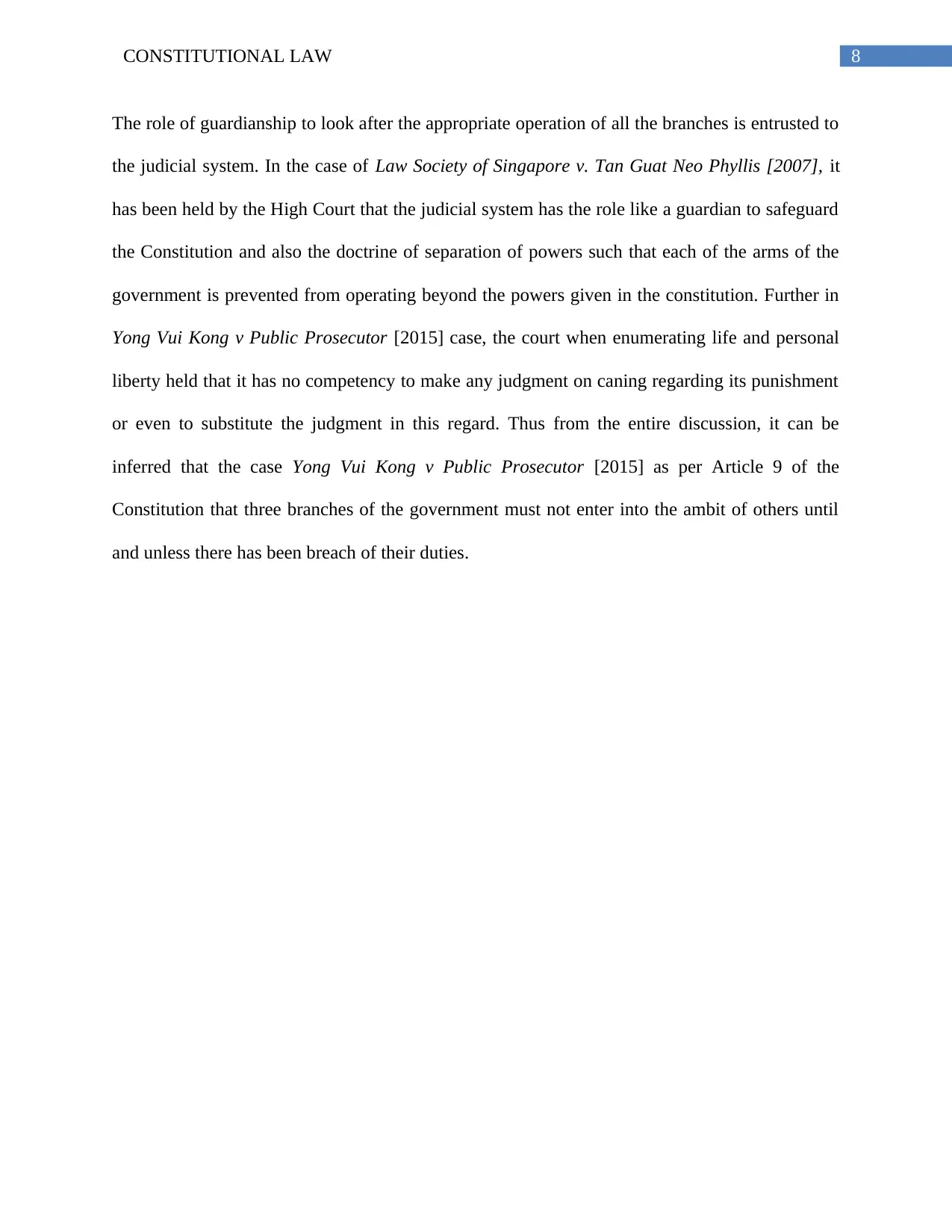
8CONSTITUTIONAL LAW
The role of guardianship to look after the appropriate operation of all the branches is entrusted to
the judicial system. In the case of Law Society of Singapore v. Tan Guat Neo Phyllis [2007], it
has been held by the High Court that the judicial system has the role like a guardian to safeguard
the Constitution and also the doctrine of separation of powers such that each of the arms of the
government is prevented from operating beyond the powers given in the constitution. Further in
Yong Vui Kong v Public Prosecutor [2015] case, the court when enumerating life and personal
liberty held that it has no competency to make any judgment on caning regarding its punishment
or even to substitute the judgment in this regard. Thus from the entire discussion, it can be
inferred that the case Yong Vui Kong v Public Prosecutor [2015] as per Article 9 of the
Constitution that three branches of the government must not enter into the ambit of others until
and unless there has been breach of their duties.
The role of guardianship to look after the appropriate operation of all the branches is entrusted to
the judicial system. In the case of Law Society of Singapore v. Tan Guat Neo Phyllis [2007], it
has been held by the High Court that the judicial system has the role like a guardian to safeguard
the Constitution and also the doctrine of separation of powers such that each of the arms of the
government is prevented from operating beyond the powers given in the constitution. Further in
Yong Vui Kong v Public Prosecutor [2015] case, the court when enumerating life and personal
liberty held that it has no competency to make any judgment on caning regarding its punishment
or even to substitute the judgment in this regard. Thus from the entire discussion, it can be
inferred that the case Yong Vui Kong v Public Prosecutor [2015] as per Article 9 of the
Constitution that three branches of the government must not enter into the ambit of others until
and unless there has been breach of their duties.
⊘ This is a preview!⊘
Do you want full access?
Subscribe today to unlock all pages.

Trusted by 1+ million students worldwide
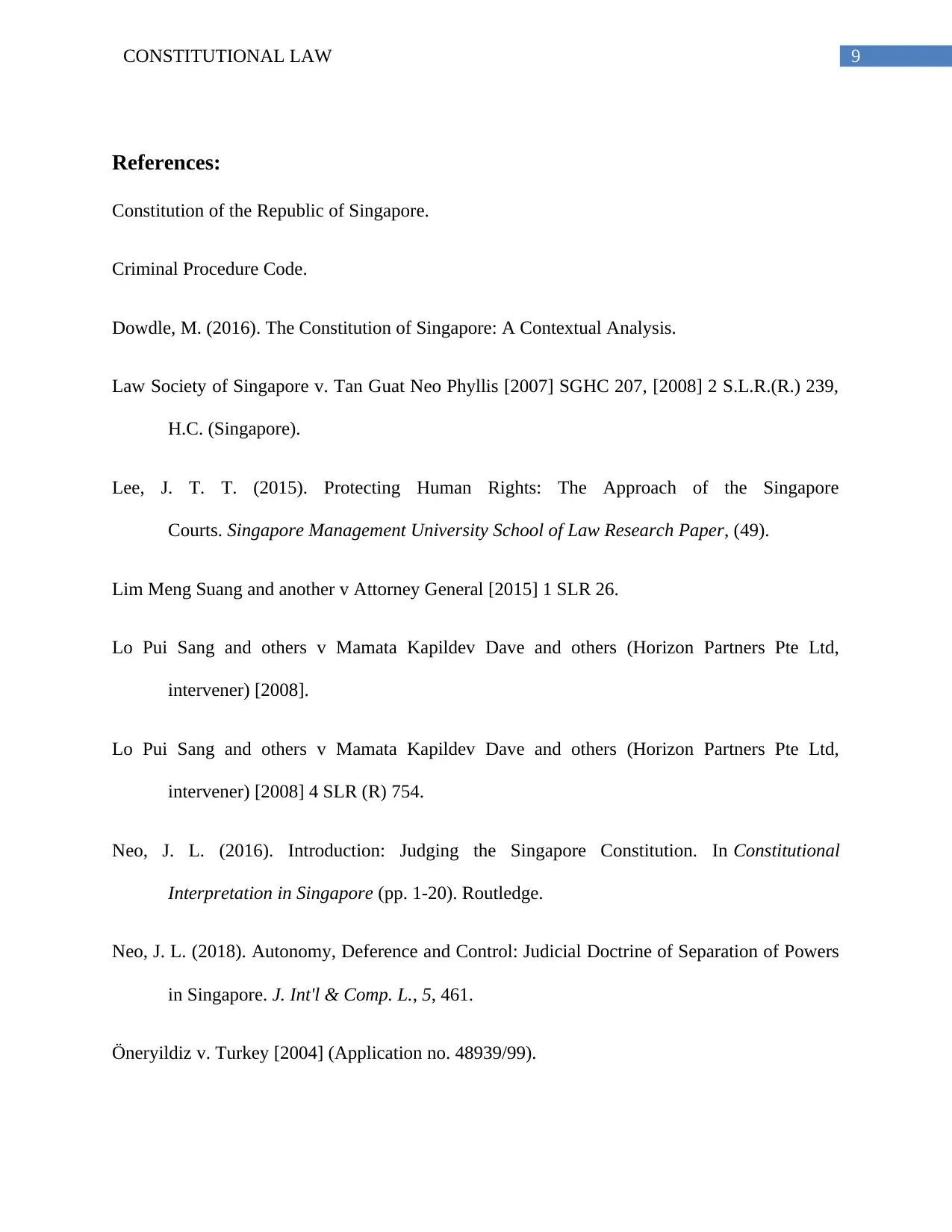
9CONSTITUTIONAL LAW
References:
Constitution of the Republic of Singapore.
Criminal Procedure Code.
Dowdle, M. (2016). The Constitution of Singapore: A Contextual Analysis.
Law Society of Singapore v. Tan Guat Neo Phyllis [2007] SGHC 207, [2008] 2 S.L.R.(R.) 239,
H.C. (Singapore).
Lee, J. T. T. (2015). Protecting Human Rights: The Approach of the Singapore
Courts. Singapore Management University School of Law Research Paper, (49).
Lim Meng Suang and another v Attorney General [2015] 1 SLR 26.
Lo Pui Sang and others v Mamata Kapildev Dave and others (Horizon Partners Pte Ltd,
intervener) [2008].
Lo Pui Sang and others v Mamata Kapildev Dave and others (Horizon Partners Pte Ltd,
intervener) [2008] 4 SLR (R) 754.
Neo, J. L. (2016). Introduction: Judging the Singapore Constitution. In Constitutional
Interpretation in Singapore (pp. 1-20). Routledge.
Neo, J. L. (2018). Autonomy, Deference and Control: Judicial Doctrine of Separation of Powers
in Singapore. J. Int'l & Comp. L., 5, 461.
Öneryildiz v. Turkey [2004] (Application no. 48939/99).
References:
Constitution of the Republic of Singapore.
Criminal Procedure Code.
Dowdle, M. (2016). The Constitution of Singapore: A Contextual Analysis.
Law Society of Singapore v. Tan Guat Neo Phyllis [2007] SGHC 207, [2008] 2 S.L.R.(R.) 239,
H.C. (Singapore).
Lee, J. T. T. (2015). Protecting Human Rights: The Approach of the Singapore
Courts. Singapore Management University School of Law Research Paper, (49).
Lim Meng Suang and another v Attorney General [2015] 1 SLR 26.
Lo Pui Sang and others v Mamata Kapildev Dave and others (Horizon Partners Pte Ltd,
intervener) [2008].
Lo Pui Sang and others v Mamata Kapildev Dave and others (Horizon Partners Pte Ltd,
intervener) [2008] 4 SLR (R) 754.
Neo, J. L. (2016). Introduction: Judging the Singapore Constitution. In Constitutional
Interpretation in Singapore (pp. 1-20). Routledge.
Neo, J. L. (2018). Autonomy, Deference and Control: Judicial Doctrine of Separation of Powers
in Singapore. J. Int'l & Comp. L., 5, 461.
Öneryildiz v. Turkey [2004] (Application no. 48939/99).
Paraphrase This Document
Need a fresh take? Get an instant paraphrase of this document with our AI Paraphraser
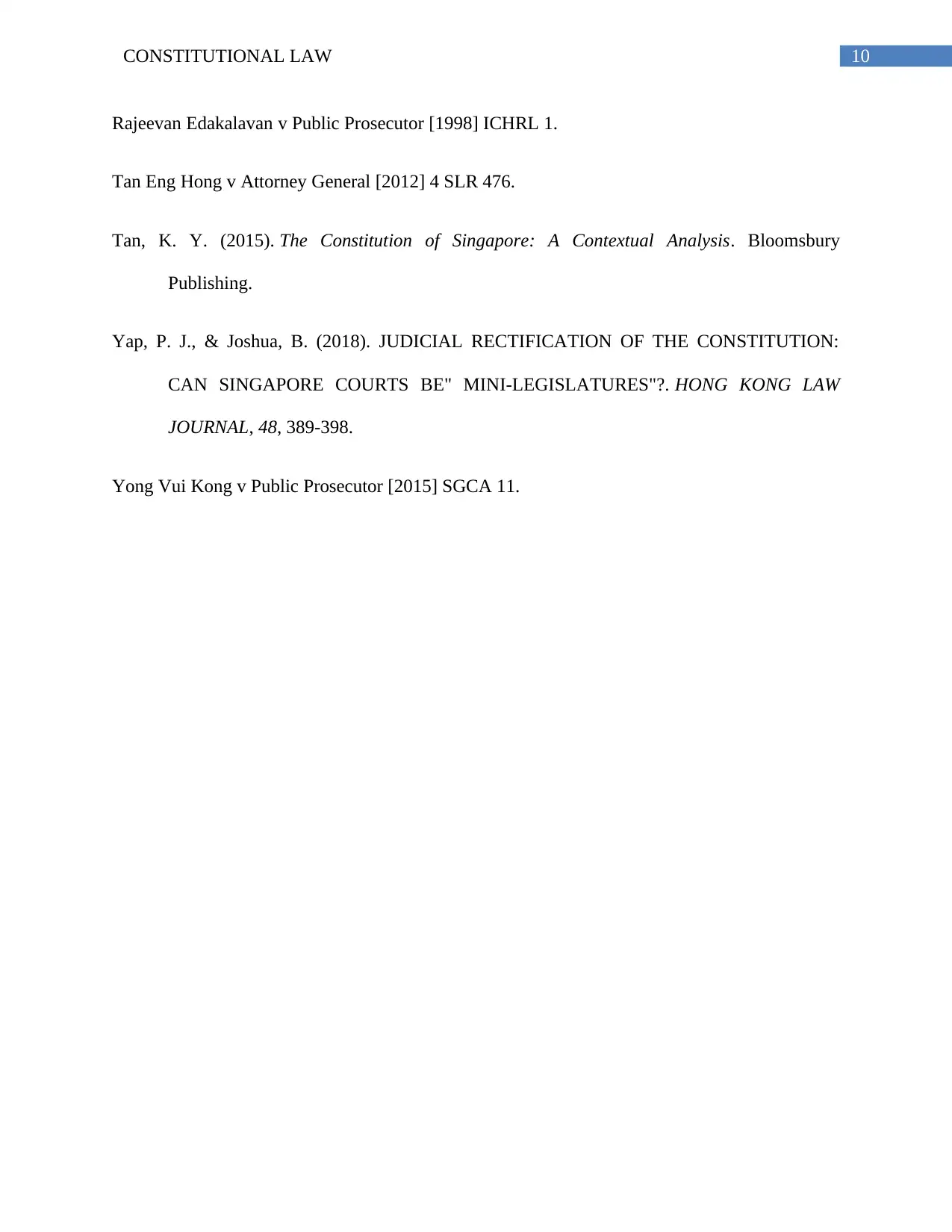
10CONSTITUTIONAL LAW
Rajeevan Edakalavan v Public Prosecutor [1998] ICHRL 1.
Tan Eng Hong v Attorney General [2012] 4 SLR 476.
Tan, K. Y. (2015). The Constitution of Singapore: A Contextual Analysis. Bloomsbury
Publishing.
Yap, P. J., & Joshua, B. (2018). JUDICIAL RECTIFICATION OF THE CONSTITUTION:
CAN SINGAPORE COURTS BE" MINI-LEGISLATURES"?. HONG KONG LAW
JOURNAL, 48, 389-398.
Yong Vui Kong v Public Prosecutor [2015] SGCA 11.
Rajeevan Edakalavan v Public Prosecutor [1998] ICHRL 1.
Tan Eng Hong v Attorney General [2012] 4 SLR 476.
Tan, K. Y. (2015). The Constitution of Singapore: A Contextual Analysis. Bloomsbury
Publishing.
Yap, P. J., & Joshua, B. (2018). JUDICIAL RECTIFICATION OF THE CONSTITUTION:
CAN SINGAPORE COURTS BE" MINI-LEGISLATURES"?. HONG KONG LAW
JOURNAL, 48, 389-398.
Yong Vui Kong v Public Prosecutor [2015] SGCA 11.
1 out of 11
Related Documents
Your All-in-One AI-Powered Toolkit for Academic Success.
+13062052269
info@desklib.com
Available 24*7 on WhatsApp / Email
![[object Object]](/_next/static/media/star-bottom.7253800d.svg)
Unlock your academic potential
Copyright © 2020–2025 A2Z Services. All Rights Reserved. Developed and managed by ZUCOL.




